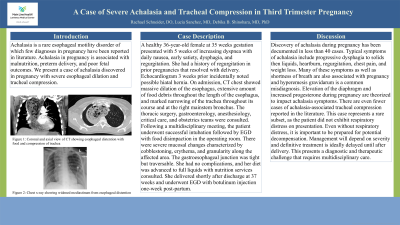Monday Poster Session
Category: Esophagus
P2312 - A Case of Severe Achalasia and Tracheal Compression in Third Trimester Pregnancy
Monday, October 28, 2024
10:30 AM - 4:00 PM ET
Location: Exhibit Hall E

Has Audio

Rachael Schneider, DO
Lankenau Medical Center
Wynnewood, PA
Presenting Author(s)
Rachael Schneider, DO, Lucia Sanchez, MD, Debika Shinohara, MD, PhD
Lankenau Medical Center, Wynnewood, PA
Introduction: Achalasia is a rare esophageal motility disorder of which few diagnoses in pregnancy have been reported in literature. Achalasia in pregnancy is associated with malnutrition, preterm delivery, and poor fetal outcomes. We present a case of achalasia discovered in pregnancy with severe esophageal dilation and tracheal compression.
Case Description/Methods: A healthy 36-year-old female at 35 weeks gestation presented with 5 weeks of increasing dyspnea with daily nausea, early satiety, dysphagia, and regurgitation. She had a history of regurgitation in prior pregnancies that resolved with delivery. Echocardiogram 3 weeks prior incidentally noted possible hiatal hernia. On admission, CT chest showed massive dilation of the esophagus, extensive amount of food debris throughout the length of the esophagus, and marked narrowing of the trachea throughout its course and at the right mainstem bronchus. The thoracic surgery, gastroenterology, anesthesiology, critical care, and obstetrics teams were consulted. Following a multidisciplinary meeting, the patient underwent successful intubation followed by EGD with food disimpaction in the operating room. There were severe mucosal changes characterized by cobblestoning, erythema, and granularity along the affected area. The gastroesophageal junction was tight but traversable. She had no complications, and her diet was advanced to full liquids with nutrition services consulted. She delivered shortly after discharge at 37 weeks and underwent EGD with botulinum injection one-week post-partum.
Discussion: Discovery of achalasia during pregnancy has been documented in less than 40 cases. Typical symptoms of achalasia include progressive dysphagia to solids then liquids, heartburn, regurgitation, chest pain, and weight loss. Many of these symptoms as well as shortness of breath are also associated with pregnancy and hyperemesis gravidarum is a common misdiagnosis. Elevation of the diaphragm and increased progesterone during pregnancy are theorized to impact achalasia symptoms. There are even fewer cases of achalasia-associated tracheal compression reported in the literature. This case represents a rare subset, as the patient did not exhibit respiratory distress on presentation. Even without respiratory distress, it is important to be prepared for potential decompensation. Management will depend on severity and definitive treatment is ideally delayed until after delivery. This presents a diagnostic and therapeutic challenge that requires multidisciplinary care.

Disclosures:
Rachael Schneider, DO, Lucia Sanchez, MD, Debika Shinohara, MD, PhD. P2312 - A Case of Severe Achalasia and Tracheal Compression in Third Trimester Pregnancy, ACG 2024 Annual Scientific Meeting Abstracts. Philadelphia, PA: American College of Gastroenterology.
Lankenau Medical Center, Wynnewood, PA
Introduction: Achalasia is a rare esophageal motility disorder of which few diagnoses in pregnancy have been reported in literature. Achalasia in pregnancy is associated with malnutrition, preterm delivery, and poor fetal outcomes. We present a case of achalasia discovered in pregnancy with severe esophageal dilation and tracheal compression.
Case Description/Methods: A healthy 36-year-old female at 35 weeks gestation presented with 5 weeks of increasing dyspnea with daily nausea, early satiety, dysphagia, and regurgitation. She had a history of regurgitation in prior pregnancies that resolved with delivery. Echocardiogram 3 weeks prior incidentally noted possible hiatal hernia. On admission, CT chest showed massive dilation of the esophagus, extensive amount of food debris throughout the length of the esophagus, and marked narrowing of the trachea throughout its course and at the right mainstem bronchus. The thoracic surgery, gastroenterology, anesthesiology, critical care, and obstetrics teams were consulted. Following a multidisciplinary meeting, the patient underwent successful intubation followed by EGD with food disimpaction in the operating room. There were severe mucosal changes characterized by cobblestoning, erythema, and granularity along the affected area. The gastroesophageal junction was tight but traversable. She had no complications, and her diet was advanced to full liquids with nutrition services consulted. She delivered shortly after discharge at 37 weeks and underwent EGD with botulinum injection one-week post-partum.
Discussion: Discovery of achalasia during pregnancy has been documented in less than 40 cases. Typical symptoms of achalasia include progressive dysphagia to solids then liquids, heartburn, regurgitation, chest pain, and weight loss. Many of these symptoms as well as shortness of breath are also associated with pregnancy and hyperemesis gravidarum is a common misdiagnosis. Elevation of the diaphragm and increased progesterone during pregnancy are theorized to impact achalasia symptoms. There are even fewer cases of achalasia-associated tracheal compression reported in the literature. This case represents a rare subset, as the patient did not exhibit respiratory distress on presentation. Even without respiratory distress, it is important to be prepared for potential decompensation. Management will depend on severity and definitive treatment is ideally delayed until after delivery. This presents a diagnostic and therapeutic challenge that requires multidisciplinary care.

Figure: CT (panel 1 and 2) and X-ray (panel 3) imaging showing severe esophageal dilation and tracheal compression
Disclosures:
Rachael Schneider indicated no relevant financial relationships.
Lucia Sanchez indicated no relevant financial relationships.
Debika Shinohara indicated no relevant financial relationships.
Rachael Schneider, DO, Lucia Sanchez, MD, Debika Shinohara, MD, PhD. P2312 - A Case of Severe Achalasia and Tracheal Compression in Third Trimester Pregnancy, ACG 2024 Annual Scientific Meeting Abstracts. Philadelphia, PA: American College of Gastroenterology.
